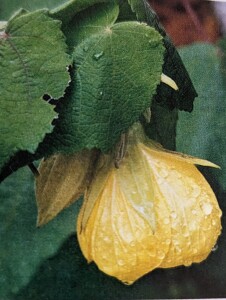 I have had a crush on abutilon or “parlor maple” plants for the longest time. It might be because I love their hollyhock-like flowers. Or perhaps it is because I live in a Victorian house and the room that I refer to as the” living room” would once have been called “the parlor”. It stands to reason that parlors cry out for parlor maples. I know mine does. It might also be that while winter is not even one third over—officially that is—I am longing for more color in my life and in my house.
I have had a crush on abutilon or “parlor maple” plants for the longest time. It might be because I love their hollyhock-like flowers. Or perhaps it is because I live in a Victorian house and the room that I refer to as the” living room” would once have been called “the parlor”. It stands to reason that parlors cry out for parlor maples. I know mine does. It might also be that while winter is not even one third over—officially that is—I am longing for more color in my life and in my house.
Parlor maples are sometimes also known as “Chinese lanterns”, “flowering maple” or even “Indian maple”. Sticklers for proper Latin names refer to the common commercial varieties as Abutilon x hybridum, which means that the plants in question are the result of successful crosses between two or more abutilon species. As with humans, ancestry can be complicated.
What is not complicated is the enduring popularity of parlor maples. The species and hybrids are classified as small, frost-tender subshrubs, which simply means that they the plants combine woody stems with relatively small stature—usually two to four feet-tall. Parlor maple enthusiasts who live in cold-winter climates can easily grow parlor maples as houseplants and keep size at a reasonable level by pruning regularly and conquering the urge to repot in ever larger containers.
The “maple” part of the parlor maple name comes from the fact that the plants’ lobed leaves resemble maple foliage. The resemblance goes no deeper. Maples are part of the Acer genus and parlor maples belong to the large Malvaceae or mallow family that is also home to hollyhocks, hibiscus, okra and cotton. Like many mallows, abutilon flowers sport five large petals apiece, except in double flowered forms, like the frilly pink ‘Victorian Lady’. Those petals surround a prominent central staminal column that is also characteristic of most other common mallows.
When the Victorians grew parlor maples in their parlors or conservatories, the flowers were bell-shaped and pendulous, in shades of yellow, orange, pink or red. That situation persisted, and even as recently as 1997, when celebrated plantsmen Roger Phillips and Martyn Rix produced their lavishly illustrated book, Indoor and Greenhouse Plants, all the parlor maples shown had bell-shaped blooms. Now the story has changed. Some modern plants, like the flashy ‘Red Tiger’ with petals feathered in yellow and red, still bear flowers in that shape, but breeders, like the prolific Staten Island plant maven Sage Reynolds, have produced many stellar varieties with outward-facing flowers. The color range has also expanded as well, and includes peachy shades as well as bi-colors. Some varieties, like the Thompsonii variety of Abutilon pictum, feature leaves variegated in cream.
Breeders have also answered the current demand for smaller varieties, introducing cultivars like ‘Little Sunshine’, with yellow blooms and a maximum height of two feet. Even the smallest parlor—or apartment kitchen—can accommodate abutilons in the ‘Bella’ series that grow to only 15 inches.
Those of us in cold winter climates can keep our parlor maples indoors in the late fall, winter and early spring, before giving them summer vacations outside if living arrangements permit it. Indoors, the plants need bright, south-facing windowsills, if possible, or the brightest available windowsill if windowsill space is limited. Do not position them near heat sources and do provide regular moisture, as dryness is anathema to abutilons. The plants may flower in winter, especially if they are modern hybrids, but growth and flowering generally slows down during the colder, darker months. This may be a relief, as we humans tend to slow down at the same time.
When and if the plants move outdoors, they should be given light shade at first and then moved to sunnier locations. The containers can fill holes in beds and borders, something the Victorians did all the time, but will also look good dropped into window boxes or positioned on porches or patios. Feed with houseplant fertilizer, diluted and administered according to manufacturer’s directions.
As I recall, I last killed an abutilon nine years ago. I have learned a few things since then, so I have ordered another, which should arrive just about the time when the last of my amaryllis plants have finished blooming. It is the peachy ‘Blushing Moonlight’, a Sage Reynolds hybrid. It will arrive in a 2.5-inch pot, so immediate flowering is impossible. Still, with the waning of the amaryllis, I will be motivated to do everything necessary to get my new plant going for its first flush of bloom next summer.
In winter you can either sink into Seasonal Affective Disorder or spend your time looking forward to the new growing season. I choose to do the latter.
If the Victorian that lurks inside you wants its own parlor maple, try Logee’s, 141 North Street, Danielson, CT 06239, (860) 774-8038, www.logees.com. Print catalog available.
